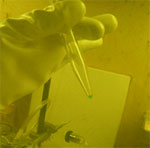International team discovers element 117
09 Apr 2010
An international team of scientists from Russia and the United States, including two Department of Energy national laboratories and two universities, has discovered the newest superheavy element, element 117.
 |
| Berkelium-249, contained in the greenish fluid in the tip of the vial, was crucial to the experiment that discovered element 117. It was made in the research reactor at DOE's Oak Ridge National Laboratory. |
Academician Yuri Oganessian, scientific leader of the Flerov Laboratory of Nuclear Reactions at JINR and spokesperson for the collaboration said, "The discovery of element 117 is the culmination of a decade-long journey to expand the periodic table and write the next chapter in heavy element research."
The team established the existence of element 117 from decay patterns observed following the bombardment of a radioactive berkelium target with calcium ions at the JINR U400 cyclotron in Dubna. The experiment depended on the availability of special detection facilities and dedicated accelerator time at Dubna, unique isotope production and separation facilities at Oak Ridge, and distinctive nuclear data analysis capabilities at Livermore.
"This is a significant breakthrough for science," LLNL director George Miller said. "The discovery of a new element provides new insight into the makeup of the universe and is a testimony to the strength of science and technology at the partner institutions."
"This collaboration and the discovery of element 117 demonstrates the fundamental importance of scientists from different nations and institutions working together to address complex scientific challenges," ORNL director Thom Mason said. The two-year experimental campaign began at the High Flux Isotope Reactor in Oak Ridge with a 250-day irradiation in the world's most intense neutron flux to produce 22 mg of berkelium. This was followed by 90 days of processing at Oak Ridge to separate and purify the berkelium, target preparation at Dimitrovgrad, 150 days of bombardment at one of the world's most powerful heavy ion accelerators at Dubna, data analysis at Livermore and Dubna, and assessment and review of the results by the team. The entire process was driven by the 320-day half-life of the berkelium target material.













.jpg)






.jpg)









